
The speckled wood is a butterfly found in and on the borders of woodland areas throughout much of the Palearctic realm. The species is subdivided into multiple subspecies, including Pararge aegeria aegeria, Pararge aegeria tircis, Pararge aegeria oblita, and Pararge aegeria insula. The color of this butterfly varies between subspecies. The existence of these subspecies is due to variation in morphology down a gradient corresponding to a geographic cline. The background of the wings ranges from brown to orange, and the spots are either pale yellow, white, cream, or a tawny orange. The speckled wood feeds on a variety of grass species. The males of this species exhibit two types of mate locating behaviors: territorial defense and patrolling. The proportion of males exhibiting these two strategies changes based on ecological conditions. The monandrous female must choose which type of male can help her reproduce successfully. Her decision is heavily influenced by environmental conditions.

The meadow brown is a butterfly found in the Palearctic realm. Its range includes Europe south of 62°N, Russia eastwards to the Urals, Asia Minor, Iraq, Iran, North Africa and the Canary Islands. The larvae feed on grasses.

Melanargia galathea, the marbled white, is a medium-sized butterfly in the family Nymphalidae. Despite its common name and appearance, this butterfly is one of the "browns", of the subfamily Satyrinae.

Lasiommata megera, the wall or wall brown, is a butterfly in the family Nymphalidae. It is widespread in the Palearctic realm with a large variety of habitats and number of generations a year.

Hipparchia fatua, or Freyer's grayling, is a butterfly of the family Nymphalidae. The species can be found from the Balkans, through Anatolia up to Iran.
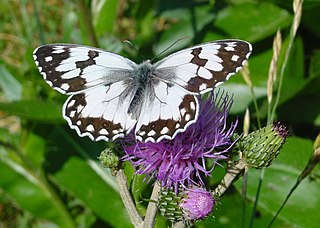
Melanargia lachesis, the Iberian marbled white, is a butterfly species belonging to the family Nymphalidae. It can be found on the Iberian Peninsula and the south of France.

Melanargia ines, the Spanish marbled white, is a butterfly species belonging to the family Nymphalidae. It can be found on the Iberian Peninsula and western North Africa.

Melanargia occitanica, the western marbled white, is a butterfly species belonging to the family Nymphalidae. It can be found in North Africa and south western Europe.
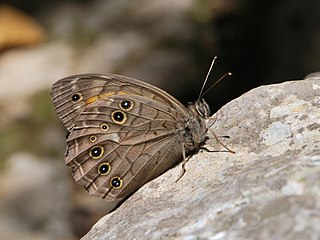
Kirinia roxelana, the lattice brown, is a butterfly of the family Nymphalidae. It is found in southeastern Europe and the Near East. The butterfly is on wing between May and July. The larvae feed on various grasses.
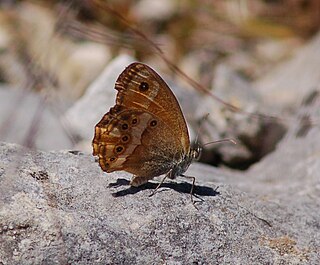
Coenonympha dorus, the dusky heath, is a butterfly of the family Nymphalidae. It is found in south-western Europe and North Africa.

Chazara briseis, the hermit, is a butterfly species belonging to the family Nymphalidae. It can be found in North Africa, southern Europe, Asia Minor, the Caucasus, Kazakhstan, Central Asia through Afghanistan, and north-western China and Tuva. It is found on steppe and in other dry grassy places between 500 and 2,500 meters.

Pararge is a genus of butterflies of the family Nymphalidae.

Vanessa vulcania, the Canary red admiral, is a butterfly of the family Nymphalidae. It is found on the Canary Islands and Madeira. Previously, it was considered a subspecies of Vanessa indica, but has been raised to species level after research by Leestmans in 1992.

Pseudochazara anthelea is a species of butterfly in the family Nymphalidae. It is found in Albania, the Republic of Macedonia, Bulgaria, Greece, Turkey and northern Iraq. The males can be easily distinguished from the females by the white base and they are found in dry, stony slopes and gullies, usually on limestone.
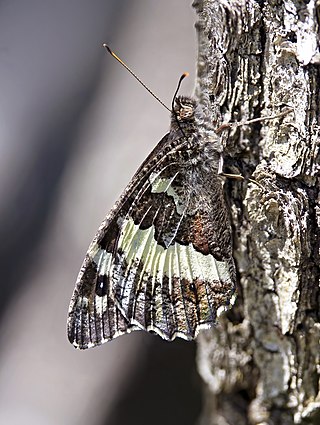
Brintesia is a monotypic butterfly genus in the family Nymphalidae and subfamily Satyrinae. Its one species is Brintesia circe, the great banded grayling.

Chazara prieuri, the southern hermit, is a butterfly species belonging to the family Nymphalidae. It can be found in Morocco and Spain.

Pseudochazara beroe is a species of butterfly in the family Nymphalidae. It is found from western Turkey across southern Transcaucasia and the Elburz Mountains to Kopet-Dagh.
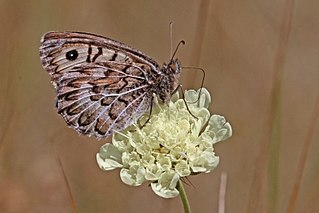
Pseudochazara geyeri, the Grey Asian grayling is a species of butterfly in the family Nymphalidae. It is confined to Albania, Greece, North Macedonia, eastern Turkey and south-western Transcaucasia.

Pseudochazara graeca is a species of butterfly in the family Nymphalidae. In Greece it is confined to Mount Parnassus, Mount Olympus, Mount D'rfis, Mount Chelmos, Mount Panakhaikon, Mount Menalon, Mount Mainalo, Mount Taygetus and Katara Pass in the Pindus Mountains. In North Macedonia it is found on Pelister.

Arethusana is a butterfly genus from the subfamily Satyrinae of the brush-footed butterfly family (Nymphalidae). It is composed of only one species, Arethusana arethusa, the false grayling.




















